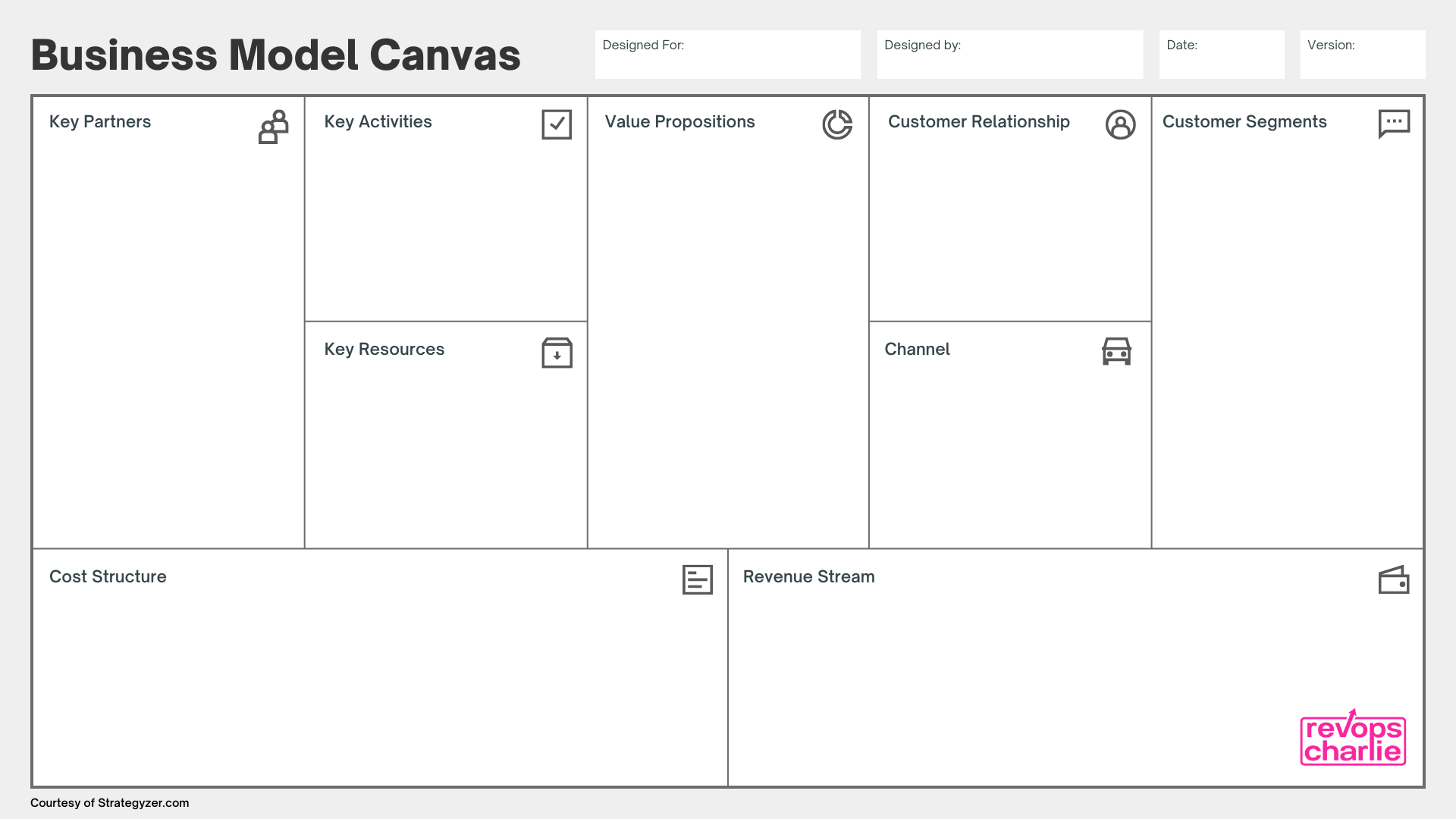How to use a business model canvas to build a repeatable GTM playbook
As your business scales, it is tempting to just keep putting one foot in front of the other, to get through the next day, make that one change to the product, or make that one next hire.
That iterative behaviour is exactly what you needed as you searched for product market fit, and fought your way up towards a Seed and then Series A funding.
At Series A / $3m ARR you have a new task in front of you, and that is to define a repeatable playbook that you can scale predictably up to $10m ARR and your next round of investment.
A business model canvas can be a useful exercise for your team to take a step outside of your company and look inwards from your customer’s perspective.
In my workshops I use the Strategyzer Business Model Canvas which breaks a company down into 9 segments.
Customer Segments - industries, company size, personas, demographics
Value Propositions - the problems/opportunities that the customer wants solving and how the solution meets those needs.
Customer Relationships - new acquisitions or ongoing, personalised or self serve, individual or one to many
Channels - how the customer finds out about the company, purchases and gets supported
Key Activities - what the company needs to do to deliver the value proposition - product development, hire the team, sign up partners
Key Resources - what the company needs to have to deliver the value proposition - money, people, intellectual property, buildings
Key Partners - what partnerships are required to deliver the value proposition - technology partners, consulting partners, data partners, recruiting partners
Revenue Streams - how can we monetise the value proposition - SaaS, professional services fees, licensing, extra support, enterprise agreements, consumption based, user based,
Cost Structure - what will it cost us to deliver this value proposition - people, development, offices, marketing, partnerships
Start with a company everyone knows
To help get the thinking going I start by asking each team to run a well known company through the model - Ikea, Uber, Apple…
In this example the team worked through Uber - a really interesting choice as they are a multi-sided marketplace with both riders and drivers as customers.
And as the team found out, as you consider Uber Eats they have two further sets of customers, and then Uber Freight…
The team that thought they had a clear understanding of the business suddenly found it to be much more complex.
Map your company to the Business Model Canvas
Having understood how the different segments interrelate, the remainder of the full day workshop guides the teams through mapping either their current business model, or evaluating new ideas that the team have.
Depending on the number of attendees, we ideally split into multiple teams to generate different viewpoints based on different customer segments (an SMB segment will drive a different set of responses to an Enterprise segment)
By defining your customer segments first (and not the product you want to sell) it forces your team to step into your customer’s shoes and really think from their perspective:
They are a retail company
They sell online and instore
They are in multiple countries
They have a staff attrition problem
It takes them too long to get a new design into the stores
As your teams then start evaluating the Value Propositions, they are thinking about the problems or opportunities from the customer’s perspective - and not thinking how the new feature you just released can be sold to the customer.
The customer wants to move faster
The customer needs to support multi-national users
The customer wants to increase the percentage of online sales
The customer wants to sell into a new demographic
Following this process through each of the canvas categories your teams will develop a new perspective on your day to day business, generating multiple ideas that you can prioritise for prototyping prior to adding into your core model.
Look for unexpected outcomes
As your team thinks inwards from the perspective of your customer you will find some unexpected outcomes.
Channels - instead of thinking outwards about the partners you want to work with, you’ll uncover partners that your customer trusts to advise, sell and support them.
Customer relationships - you will uncover different ways that your customers want to interact with you - maybe they want more than the transactional mass market relationship and want to be part of a close-knit community.
Revenue Streams - are your customers open to paying for your offering in different ways to the traditional SaaS user model you built?
The business model canvas is not the playbook
The business model canvas provides you with a high level guide to the overall business for a specific customer segment.
You will have multiple canvases to cover different customer types by size or industry.
You will have multiple canvases for different products or services you offer.
The canvases are not the playbooks - but they are the input into creating those playbooks.
The canvases define the proposition you have for a specific customer segment, how you will communicate, sell and support that proposition, the channels you will use and how you will monetise them.
You can have a business model canvas without a playbook, but you can’t have an accurate playbook without the business model canvas.
Get started
Whenever you are ready, there are three ways that I can help you accelerate your revenue.
Buyer Experience Audit - I’ll impersonate a buyer researching your segment and company and let you know what I find. Ideal for planning your Revenue Operations strategy.
Business Model Design Workshops - I’ll work with you and your team to design or refine a business model for a new or existing product.
RevOps Impact Playbooks - I’ll help you implement one or more tactical processes across your revenue teams - content, referrals, testimonials, adoption and more.


